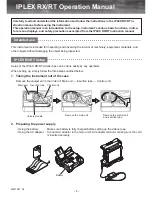
ADT7476
Rev. B | Page 35 of 72
Calculating Fan Speed
Assuming a fan with two pulses per revolution and the
ADT7476 programmed to measure two pulses per revolution,
fan speed is calculated by
Fan Speed (RPM)
= (90,000 × 60)/
Fan TACH Reading
where
Fan TACH Reading
is the 16-bit fan tachometer reading.
Example
TACH1 High Byte Register (0x29) = 0x17
TACH1 Low Byte Register (0x28) = 0xFF
What is Fan 1 speed in RPM?
Fan 1 TACH Reading
= 0x17FF = 6143 (decimal)
RPM
= (
f
× 60)/
Fan 1 TACH Reading
RPM
= (90,000 × 60)/6143
Fan Speed
= 879 RPM
Fan Pulses per Revolution (0x7B)
Different fan models can output one, two, three, or four TACH
pulses per revolution. Once the number of fan TACH pulses is
determined, it can be programmed into the fan pulses per
revolution register (0x7B) for each fan. Alternatively, this
register can be used to determine the number or pulses per
revolution output by a given fan. By plotting fan speed measure-
ments at 100% speed with different pulses per revolution set-
ting, the smoothest graph with the lowest ripple determines the
correct pulses per revolution value.
Fan Pulses per Revolution Register
Bits [1:0] Fan 1 default = 2 pulses per revolution.
Bits [3:2] Fan 2 default = 2 pulses per revolution.
Bits [5:4] Fan 3 default = 2 pulses per revolution.
Bits [7:6] Fan 4 default = 2 pulses per revolution.
00 = 1 pulse per revolution
01 = 2 pulses per revolution
10 = 3 pulses per revolution
11 = 4 pulses per revolution
Fan Spin-Up
The ADT7476 has a unique fan spin-up function. It spins the
fan at 100% PWM duty cycle until two TACH pulses are de-
tected on the TACH input. Once two TACH pulses are detected,
the PWM duty cycle goes to the expected running value, for
example, 33%. The advantage is that fans have different spin-up
characteristics and take different times to overcome inertia. The
ADT7476 runs the fans just fast enough to overcome inertia
and is quieter on spin-up than fans programmed to spin up for
a given spin-up time.
Fan Start-up Timeout
To prevent the generation of false interrupts as a fan spins up,
because it is below running speed, the ADT7476 includes a fan
start-up timeout function. During this time, the ADT7476
looks for two TACH pulses. If two TACH pulses are not
detected, an interrupt is generated.
Fan start-up timeout can be disabled by setting Bit 5 (FSPDIS)
of Configuration Register 1 (0x40).
PWM1, PWM2, PWM3 Configuration Registers
(0x5C, 0x5D, and 0x5E)
Bits [2:0] SPIN, start-up timeout for PWM1 = 0x5C, PWM2 =
0x5D, and PWM3 = 0x5E.
000 = No startup timeout
001 = 100 ms
010 = 250 ms default
011 = 400 ms
100 = 667 ms
101 = 1 second
110 = 2 second
111 = 4 second
Disabling Fan Startup Timeout
Although fan startup makes fan spin-ups much quieter than
fixed-time spin-ups, the option exists to use fixed spin-up
times. Setting Bit 5 (FSPDIS) to 1 in Configuration Register 1
(0x40) disables the spin-up for two TACH pulses. Instead, the
fan spins up for the fixed time as selected in Register 0x5C to
Register 0x5E.
PWM Logic State
The PWM outputs can be programmed high for 100% duty
cycle (noninverted) or low for 100% duty cycle (inverted).
PWM1 Configuration Register (0x5C)
Bit 4 INV.
0 = Logic high for 100% PWM duty cycle.
1 = Logic low for 100% PWM duty cycle.
PWM2 Configuration Register (0x5D)
Bit 4 INV.
0 = Logic high for 100% PWM duty cycle.
1 = Logic low for 100% PWM duty cycle.
PWM3 Configuration Register (0x5E)
Bit 4 INV.
0 = Logic high for 100% PWM duty cycle.
1 = Logic low for 100% PWM duty cycle.
Low Frequency Mode PWM Drive Frequency
The PWM drive frequency can be adjusted for the application.
Register 0x5F to Register 0x61 configure the PWM frequency
for PWM1 to PWM3, respectively.
www.BDTIC.com/ADI
















































